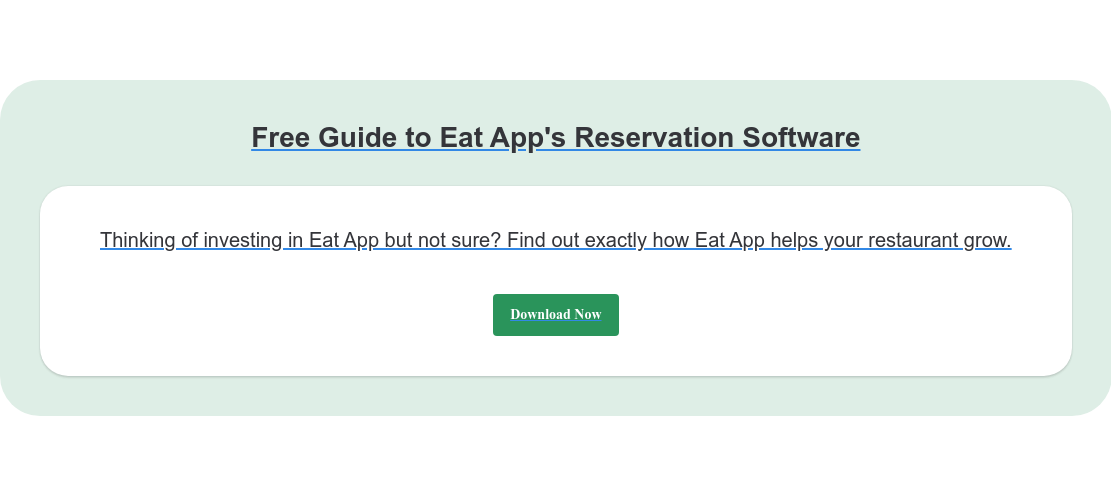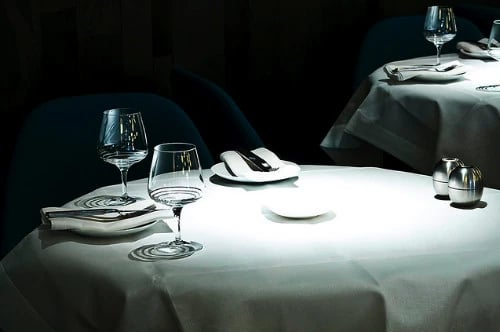No-shows happen when guests make a reservation but don’t show up - and they can seriously hurt your bottom line.
Let’s break it down. If you run a 100-seat restaurant and 50% of your guests book reservations, with an average spend of $30 per person, a 10% no-show rate means losing $150 daily or $1,000 a week.
For fine-dining spots, it’s even worse. At Alinea, Chef Grant Achatz’s Michelin-starred restaurant, just two no-shows can wipe out profits for the night.
A solid no-show policy helps. Here are strategies to reduce last-minute cancellations and keep your tables full.
We would have nights with a dozen or so no-shows at peak periods. I would think over the course of the summer, it would be around a $30,000 hit
13 strategies to reduce restaurant no-shows
Without further ado, here are 13 proven strategies that help you reduce no-shows in your restaurant.
1. Help guests understand the impact of no-shows
%20(1).webp?width=800&height=534&name=image1%20(6)%20(1).webp)
To resolve the no-show problem in your restaurant, you can first educate diners about how no-shows affect your business. Do so by sharing the challenges restaurant staff faces and the ecological aspect of wasted food.
Help them understand that the no-shows are not only an issue because of the lost revenue but also impact the employees and the environment.
2. Charge a reservation fee
One of the methods of reducing no-shows at a restaurant is to create liability on a diner for missing a reservation by charging a booking deposit, implementing a cancellation fee, or holding credit card details in case of no-shows.
The Eat App reservation system already involves an upfront payment solution, enabling prepaid reservations that prevent empty tables.
Such policies are unlikely to be popular with the customers asked to pay a penalty, but owners recognize that some flexibility is required when applying the rules.
Restaurateur Mark Greenaway told the Edinburgh Evening News: “If two people turn up when a table of four has booked, am I realistically going to charge the two diners double the price? No, because I'm not trying to annoy my customers. I'm trying to stop the no-shows.
This solution is not ideal for smaller restaurants, however, it can be adapted. You can hold the down payment and offer it as vouchers for your no-show guests to use on another occasion.
3. Consider non-refundable ticketing
%20(1).webp?width=800&height=533&name=image2%20(5)%20(1).webp)
If you have to pay upfront for flights, football matches, and theatre, has the time come to end the table booking free-for-all?
Many fine-dining restaurants offering tasting or fixed event menus have chosen to go down the ticketing route, asking diners to purchase tickets in advance to cover their costs.
Therefore, this non-refundable ticketing acts as an insurance policy for the business if the diner cannot attend.
If the customer then decides to cancel, the restaurant may be able to re-sell their ticket, allowing the customer to recover their money. However, much like if you'd bought tickets to the theater or a concert, there's no guarantee of a refund at the eleventh hour.
4. Restrict reservations
The math is simple - if there is no restaurant reservation online, there will be no restaurant no-shows. If you own a popular restaurant, you could try going reservation-free or restricting reservations to less busy times.
However, some challenges come with reduced restaurant booking. Depending on location and layout, this isn’t always practical since you may not have space for walk-in customers to wait.
It’s also harder to predict staffing and stock requirements when you’re unsure how many people you will likely be catering for that day.
%20(1).webp?width=800&height=456&name=image4%20(6)%20(1).webp)
5. Use overbooking to your advantage
Strategic overbooking is an efficient strategy to manage restaurant capacity. Many restaurants can benefit from being slightly overbooked and reduce the risk of restaurant no-shows affecting their revenue.
To incorporate overbooking strategically, you need to analyze the essential data: on which days and times the no-shows often take place, whether it happens with online reservations or the ones made with phone calls, etc.
Also, look at your restaurant's stretched capacity to find out how many diners you can accommodate at a time without affecting the guest experience. Try to only book up to that number.
Every month I do a full report on the data analysis from the cancellation to visitors, from covers, and all of this
6. Make cancellations easier
Many diners don’t cancel reservations simply because it’s not easy enough. When the process is seamless, they’re more likely to cancel in advance, reducing no-shows.
The simplest way to do this? Use reservation software like Eat App. It lets guests cancel directly through their confirmation email in just a few clicks. Even last-minute cancellations give you a chance to seat a walk-in or notify someone on your online waitlist.
But there’s a downside - making cancellations too easy can lead to guests booking multiple restaurants with no real intent to show up. A stricter policy, like restricting cancellations within 24 hours of the reservation, helps reduce no-shows while keeping things manageable for diners.
7. Track repeat offenders
Tracking repeat no-shows can help you manage unreliable diners more effectively.
You can reach out via email, WhatsApp or SMS to acknowledge their missed reservations and offer an incentive for their next visit. Alternatively, you could enforce stricter policies, like blocking frequent no-shows from booking again.
While a simple Excel sheet works, it’s not scalable. Most reservation systems track guest history automatically. With Eat App, you can even tag guests who exceed a set number of no-shows, keeping your staff informed and your tables full.
8. Send reservation reminders
Sending a reminder 24–48 hours before a reservation helps guests remember their booking and cancel in advance if needed.
You can do this with a quick call or, if you use a reservation system, set up automated email and SMS reminders. It’s a simple step, but it can significantly cut down on no-shows.
With Eat App, you can track upcoming bookings, enable automatic reminders, and reach out to guests on time, keeping your tables full and your revenue steady.
9. Reward punctual customers
Another simple way of encouraging people to be punctual and not skip their reservations is to incentivize it by acknowledging and thanking them for honoring their commitment.
Providing them with a complimentary dessert, a voucher for their next visit, and, most importantly, an impeccable dining experience reduces no-shows at your restaurant.
10. Use tech to reduce no-shows efficiently
With the help of restaurant reservation software such as Eat App, you can get valuable insights into when, how, and why the no-shows occur. Data analytics help you prevent no-shows by predicting booking patterns, customer behavior, and cancellation rates.
Furthermore, the no-show reports can allow your staff to improve the guest experience by allocating the potential no-shows to walk-ins and preventing food waste.
Here are other ways a good reservation software can be a game-changer:
- Easy reservation changes for diners
- Automated confirmation and reminder emails
- Track no-shows with guest history and tags
- Collect reservation deposits upfront
- Sell event tickets (e.g., New Year's Eve, brunches)
- Virtual waitlist for automatic table allocation
- Centralized guest profiles with contact details for quick follow-ups
Related content: Read about Eat App's automation feature
11. Send follow-ups to no-shows
In order to truly prevent future guests from bailing on their reservation, try to understand why the no-shows happened in the first place.
We are bound to have cancellations and no-shows. Our main goal should be to follow up and analyze as to why this situation occurred - Did the customer find a bad review of us? Was there a better offer from somewhere else? Did someone in their group go through a bad experience dining with us? Taking these thoughts into consideration we should reschedule their reservation to offer better services and to create a memorable experience.
12. Enable flexible reservations
Having in mind that guests only sometimes arrive on scheduled time, offering a reservation window within the booking system can help your reputation and prevent no-shows.
Restaurants that allow diners to book reservations on a flexible schedule can increase revenues by up to 21 percent over those that use rigid reservation timing for patrons.
Source: School of Hotel Administration.
Flexibility with the upcoming reservation can further help your staff with day-to-day table management, and enable them to accommodate walk-ins effectively in the available time slots.
13. Introduce no-show fees
%20(1).webp?width=800&height=533&name=image3%20(5)%20(1).webp)
Restaurant owners can charge their guests a no-show fee to reduce no-show situations. The purpose of the no-show costs is not to make up for the potential revenue loss but rather to inspire the guests to show up for their reservation.
No-shows not only lead to financial losses but also disrupt the potential sales from walk-in guests, affecting the overall operational efficiency of the restaurant.
Pro tip
With Eat App, restaurant owners can add a description of their cancellation policy in the online booking widget which is fully customizable by the restaurant.
Conclusion
In the restaurant industry, every guest counts. Streamlining reservations and waitlists boosts efficiency and keeps customers happy.
There’s no one-size-fits-all solution to reduce no-shows - you need to find what works best for your restaurant. While you can’t eliminate them entirely, the right strategies can make a big difference.
Want to cut no-shows with Eat App? Manage bookings, collect reservation fees, send reminders, and analyze customer trends - all in one place.
Start your 14-day free trial and see how Eat App can help your restaurant.
FAQs
What happens if you make a reservation and don't show up?
Depending on the restaurant's no-show policy, you can be charged a no-show fee or be declined from future reservations if you keep making reservations and do not show up.
How do I reduce no-show reservations?
There are different strategies to reduce restaurant no-shows. For example, you can send reservation reminders to your guests, charge a reservation fee, and educate your guests about the consequences no-shows have on your team and the environment.
How do you get kicked off of the OpenTable?
Your OpenTable account will be automatically deleted if you make four reservations that result in a no-show within 12 months.
What is a no-show in a reservation?
A restaurant no-show happens when a guest makes a table reservation and does not show up.











.webp?width=144&height=72&name=Eat%20App%20Logo%20(3).webp)